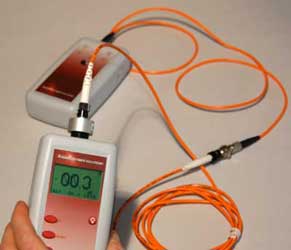Explore the latest advancements in ofda solutions for precise fibre analysis.
Wiki Article
Discovering the Perks of Optical Fibre Testing for Boosted Interaction Solutions
The significance of optical fiber testing in contemporary interaction systems can not be overstated, as it acts as a structure for guaranteeing network dependability and efficiency. Using advanced techniques such as Optical Time-Domain Reflectometry (OTDR) and insertion loss evaluation, organizations can not just determine faults yet likewise maximize their setups. This proactive screening method has extensive ramifications for signal quality and functional efficiency, increasing the question of exactly how these practices add to long-lasting sustainability in an ever-evolving technical landscape. Understanding these characteristics is vital for stakeholders intending to preserve an one-upmanship.Value of Optical Fibre Screening
The importance of optical fibre screening can not be overstated in today's data-driven atmosphere. As companies significantly count on high-speed information transmission for day-to-day operations, the integrity and performance of optical fibre networks are vital. Examining ensures that these networks can support the substantial quantities of information produced and sent flawlessly, cultivating reliable interaction and connection.Optical fiber screening offers numerous critical functions, consisting of validating installment top quality, recognizing possible mistakes, and establishing total system efficiency. Routine testing can avoid expensive downtimes and service disruptions, permitting companies to preserve operational continuity. It assists in compliance with industry criteria and guidelines, making sure that fibre optic installments satisfy needed specifications for safety and security and dependability.
Additionally, screening can improve the longevity of fiber optic systems. By proactively determining issues such as signal loss, depletion, or port failures, companies can deal with troubles before they escalate, hence prolonging the life of their infrastructure. In recap, optical fibre screening is not merely a technological demand yet a critical investment that enhances network integrity, enhances performance, and inevitably supports the development and efficiency of modern-day interaction systems.
Key Checking Methods

OTDR is an important method used to recognize mistakes, measure splice losses, and evaluate the total integrity of a fiber optic web link. By sending a pulse of light down the fiber and examining the reflected light, service technicians can pinpoint places of mistakes and evaluate the network's performance over lengthy ranges.
Insertion loss screening measures the amount of signal loss that happens when light go through a connection or splice. This technique is crucial for verifying that links fulfill specific loss thresholds, which is important for preserving optimum efficiency in interaction systems.
Optical return loss testing measures the amount of light showed back in the direction of the resource as a result of blemishes in the fiber or connections. High return loss values indicate far better efficiency and lowered signal degradation.
Together, these testing methods offer an extensive analysis of fibre optic networks, ensuring their reliability and functionality in varied interaction applications.
Effect On System Efficiency
Reliable optical fiber screening straight influences the overall performance of communication systems. By ensuring the integrity of fiber optic wires, screening recognizes potential mistakes such as depletion, splice loss, and port misalignment. These issues can considerably degrade signal top quality, bring about disruptions and reduced data transmission speeds.
Moreover, normal optical fibre screening adds to lasting system sustainability. It makes it possible for early detection of wear and tear, permitting timely upkeep and upgrades prior to major failings occur. This not just extends the lifespan of the facilities yet likewise makes certain that communication systems continue to be competitive in terms of efficiency.
Cost-Effectiveness and Efficiency
Cost-effectiveness is a vital consideration in the release and maintenance of optical fibre networks. Executing robust optical fibre testing treatments can substantially minimize functional expenses by recognizing concerns prior to they rise right into significant issues. optical fibre diameter analyser. By discovering faults, attenuation, and various other efficiency barriers early, companies can stay clear of pricey fixings and downtime, which can disrupt services and bring about revenue lossAdditionally, reliable testing techniques simplify the installation process, permitting service technicians to function better. This converts to decrease work costs and faster task completion times. Advanced screening devices, such as Optical Time Domain Reflectometers (OTDRs), makes it possible for an accurate assessment of fibre high quality, guaranteeing that just ideal products are utilized, thereby lessening waste.
Regular screening also adds to better source allocation. By recognizing the network's performance, companies can make informed choices concerning upgrades and growths, making certain that investments are made where they are most required. In ofda summary, optical fibre screening enhances cost-effectiveness and effectiveness, sustaining the long-term sustainability and competition of interaction systems in a progressively requiring market.
Ensuring Long-Term Dependability
Applying rigorous optical fibre screening not just enhances expense financial savings and operational efficiency however additionally plays a pivotal function in making sure the lasting reliability of communication networks. Constant screening techniques, including attenuation and data transfer evaluations, aid identify prospective deterioration in fiber efficiency prior to it leads to service interruptions.By utilizing sophisticated screening techniques, network drivers can determine mistakes or weak points in the fibre infrastructure, permitting timely remediation. This positive technique lessens downtime, making certain that interaction systems continue to be useful and reliable. Regular screening adds to the growth of an extra durable network, as operators can adapt and optimize their infrastructure based on real-time information understandings.
Furthermore, guaranteeing compliance with industry criteria through optical fibre screening strengthens the quality and integrity of the whole interaction system. This adherence not only bolsters self-confidence among stakeholders but additionally lines up with regulative requirements, which are significantly rigid.
Final Thought
In final thought, optical fiber screening serves as a basic component in improving interaction systems. By employing different testing techniques, such as OTDR and insertion loss assessments, networks can achieve ideal efficiency and reliability.Report this wiki page